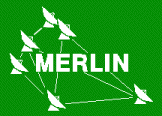
Newsletter

 |
Newsletter |  |
| Number 8: March 2003 | ||||
| MERLIN | VLBI AT JBO | PROPOSALS | ARCHIVE | CONTACT |
This newsletter may also be downloaded as a pdf file from here
| Contents | |
The deadline for the receipt of proposals for Semester 03B (October 2003 - January 2004) on MERLIN is March 15th, 2003. All details are in the MERLIN web area, specifically:
Observing frequencies available:
**Surface alignment of the Lovell telescope will be an iterative process with the first stage planned for Summer 2003. The new C-Band receivers and LOs are scheduled for installation during Semester 03B. Improvements and upgrades will be incremental and the fully enhanced sensitivity is unlikely to be realized before 2004.
The system parameters for observation of a continuum source in good weather conditions are;
| C-Band(New) | C-Band | K-Band | |
| Maximum angular resolution (mas) | ~40 | ~40 | ~8 |
| R.M.S. noise level for 12 hr. on source (microJy/beam) | ~20 | ~50 | ~400 |
| Maximum bandwidth per polarization (MHz) | ~15 | ~15 | ~15 |
The use of the fully aligned Lovell telescope at C-Band with the new receiver systems reduces the 12 hour RMS noise level to ~20 uJy/beam. The maximum rate at which the observing frequency can be switched within an observing band will be approximately once every five minutes for multi-frequency synthesis (MFS) observations. MFS is possible within each C-Band range (eg 4.5GHz-5.2GHz), but not possible between 4.5/5.2GHz and 6/7GHz. For spectral line work throughout the Semester, users are referred to Table 4.4 of the MERLIN User Guide Version 2.0. The maximum number of frequency channels per baseline to be divided between the 4 polarizations for bandwidths of 16 MHz, 8 MHz and 4 MHz are 64, 128 and 256, respectively. The number of frequency channels per baseline to be divided between the 4 polarizations will be 512 for bandwidths of 2 MHz or less. The minimum total bandwidth is 250 kHz.
Users who have obtained single-baseline (Mk2-Cambridge) data at 6-7GHz should inform the MERLIN TAG of the status of their project when applying for new observations with full MERLIN.
Proposal forms, information on MERLIN Key Programmes, and further general information can be obtained via;
As always, the last six months have been one of intense effort by the National Facility team. The e-MERLIN project is on track and we are working hard towards the first milestone: the delivery of a new 5 GHz capability and, for the first time, the inclusion of the Lovell Telescope in the array at that frequency band. We expect this milestone to be achieved towards the end of this year. The Call for Proposals (see above) describes the new capabilities in more detail. I look forward to receiving proposals to use this new capability.
You will notice that the deadline for receipt of MERLIN proposals has changed; it has moved forwards by 3 weeks and is now March 15. This shift was beyond our control and was imposed by PPARC as part of a process of rationalizing the proposal process for all UK observing facilities. I apologize for the inconvenience that this may cause to our users. Note that VLBI deadlines remain the same as always (see http://www.evlbi.org).
MERLIN is currently at L-band (1.4/1.6 GHz) and will remain so for the rest of Semester 03A. At the time of writing the Lovell Telescope has just rejoined the array and is now in full operation following its upgrade (described in previous Newsletters). We have a busy programme scheduled between now and the summer engineering break. Over the summer we will be working towards the installation of the new 5 GHz systems; will be installing the first of the L-band lens mechanisms on one of the E-systems telescopes - this will eventually lead to frequency flexibility for MERLIN. Work will also be ongoing on the surface adjustment of the Lovell Telescope and improvements in its pointing model to enable full efficiency at 5 GHz.
At the November meeting of the EVN Directors it was decided that the EVN should purchase Mk5A disc-based recording systems. Jodrell Bank Observatory has just ordered its first unit along with a number of disks and we expect to begin test observations with the rest of the EVN in the next few months. Once the system is fully operational we hope for and expect improved reliability in VLBI recording.
P. J. Diamond (pdiamond@jb.man.ac.uk)
The e-MERLIN upgrade involves replacing the narrow-band microwave links which return the radio astronomy signals to the correlator (equivalent to 128 Mb/s) with broad-band optical fibre (30 Gb/s per telescope). Together with the incorporation of the Lovell Telescope at 5 GHz, this will increase the sensitivity of MERLIN by a factor of 30, revolutionizing its performance. In addition to replacing the data connections we will be installing a new correlator capable of handling the incoming 210 Gb/s total data rate; broad-banding the C-band receivers to cover the whole band from 4 - 8 GHz; upgrading all the receivers with lower noise amplifiers; enabling all MERLIN telescopes to switch between all observing frequencies within a minute and installing new control and monitoring systems. The upgrade is jointly funded by The University of Manchester, the Northwest Development Agency, UMIST, the University of Cambridge and PPARC, with a total budget of GBP 6.8M.
The e-MERLIN science working group met in November to finalize a series of Science Reference Missions against which the proposed capabilities of e-MERLIN can be evaluated. They also discussed and endorsed minor design changes in the receiver and LO designs. A key part of the project is the optical fibre network, which will carry more traffic than most of the major UK data networks. The Invitation to Tender for the optical fibre connections for e-MERLIN was issued in December and we expect to select the prime contractor by June. We held a suppliers' day in February and were very pleased with the number of suppliers who attended and their appreciation of the nature of the project. The selection of the correlator will also be made in the same period.
Receiver development is progressing well and is described in a separate section of this Newsletter. First priority has been given to the development of the low-noise broad-band 4-8 GHz receiver along with the development of an interim down-converter, so that during the forthcoming 5GHz session, we can take advantage of the sensitivity improvements, and be able to observe at 6-6.7 GHz on all telescopes. Together with the staged surface adjustment of the Lovell Telescope, the overall sensitivity of MERLIN should be increased by a factor of 3 during this period. The prime contractor for the design and construction of the L-band lens mechanism will also be selected shortly and this will be tested on the first E-systems telescope later this year.
The new LO system, and the Control and Monitoring systems are still in the design stage: prototype systems are scheduled for later this year.
S. T. Garrington (stg@jb.man.ac.uk)
Interstellar H2O masers can be used to trace the warm, dense molecular gas associated with young stellar objects and star-forming regions. Most identified interstellar masers are associated with molecular outflows and trace the expanding shock front between the outflow and the ambient interstellar medium. However, a few appear to be associated with circumstellar discs or rings rather than the molecular outflow. The nature of these discs ultimately bears on the origin of planets since they are thought to form out of condensations within the discs. H2O masers provide a unique probe of the dynamics of such systems.
Gallimore et al. (2002,) have imaged the R4 maser complex which lies close to the continuum source Cepheus A HW2 with MERLIN 22GHz observations from April 2000. These masers were originally thought to be associated with a protoplanetary disc around the continuum source. However Torrelles et al (1998) and Gallimore et al (2002) find that the masers are not part of the HW2 continuum source. They find a self-contained system which they have modelled with a hydrodynamic shock (vs~ 13 km/s), expanding into a rotating circumstellar disc around a central unseen protostar of ~3M(solar).

|
MERLIN's supreme astrometric capabilities enables such revealing proper motion studies to be performed with relative ease.
Torrelles , J.M., et al 1998, ApJ, 509.
Gallimore, J.F., Cool, R.J., Thornley, M.D., & McMullen, J., 2002,
astro-ph/0211462
e-MERLIN requires the development of four new feed designs to cover the 4 to 8 GHz band, for the Lovell Telescope, MkII/Defford, Cambridge, and the E-Systems Telescopes (Pickmere, Darnhall, Knockin). The need, in each case, for good return loss and constant beamwidth across an octave band presents a set of difficult challenges. Ansoft's High Frequency Structure Simulator (HFSS) has been used to model designs. Work on the cassegrain telescope feeds is in progress. A prototype MkII/Defford feed (a wide flare-angle scalar horn) has been manufactured and tested, both in the laboratory and on the MkII telescope. The overall diameter of the feed is approximately 150mm.

|
The Lovell Telescope feed is a less conventional design, using a dielectric loaded circular horn with closely spaced chokes. The modelling process has been completed, engineering drawings have been produced, and a prototype feed is currently being manufactured We expect to test the prototype during March.
In order to detect circular polarization at C band we will use a combination of an Ortho-Mode Transducer (OMT) and a 90 degree 3dB hybrid coupler. Quad-ridge OMTs have been used extensively in the radio astronomy community to give wide-band polarization discrimination, and we currently use this type of OMT for MERLIN at L band. The new C band design has been modelled in HFSS, partly based on work by James and Skinner at CSIRO (see the right panel in Fig.3). Agilent's Advanced Design System (ADS) has also been used in the design of the coaxial matching sections. Manufacturing of the prototype OMT, with very good simulated performance, will shortly commence.

|
Our 90 degree hybrid is being designed by the University of Birmingham's Department of Electronic and Electrical Engineering. It will be constructed using high temperature superconducting materials, thereby ensuring that it contributes virtually no noise to the receiver.
Neil Roddis (N.Roddis@jb.man.ac.uk) and Su Yan (suyan@jb.man.ac.uk)